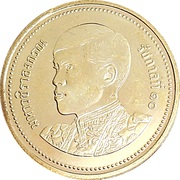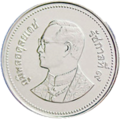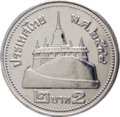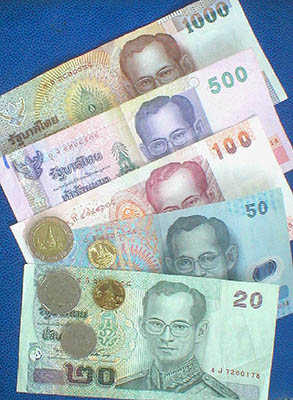
The baht is the official currency of Thailand. It is divided into 100 satang. Prior to decimalisation, the baht was divided into eight fueang, each of eight at. The issuance of currency is the responsibility of the Bank of Thailand. SWIFT ranked the Thai baht as the 10th-most-frequently used world payment currency as of December 2023.

Princess Srinagarindra born Sangwan Talapat was a member of the Royal Thai Family. She was part of the House of Mahidol, which is descended from the Chakri dynasty and was founded by Prince Mahidol Adulyadej. She was the mother of Princess Galyani Vadhana, King Ananda Mahidol, and King Bhumibol Adulyadej and was the paternal grandmother of King Vajiralongkorn.
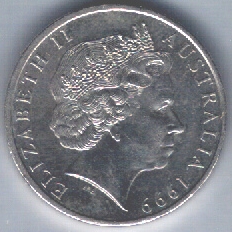
The twenty-cent coin of the Australian decimal currency system was issued with conversion to decimal currency on 14 February 1966, replacing the florin which was worth two shillings, a tenth of a pound.
The Thailand one-satang coin is a currency unit equivalent to one-hundredth of a Thai baht. It is rare in circulation but used in banking transactions.
The Thailand five-satang coin is a unit of currency equivalent to one-twentieth of a Thai baht. It was introduced in 1908 as a coin with a hole through its middle, which was minted until 1939. In 1946 the hole was removed and the new Thai monarch featured on the obverse: Rama IX. In 1996 a five-satang coin marked the 50th anniversary of his reign.
The Thailand ten-satang coin is a currency unit equivalent to one-tenth of a Thai baht. It is rare in circulation but used in banking transactions.

The Thailand fifty-satang coin is currency unit equivalent to one-half of a Thai baht. It is also called สองสลึง.
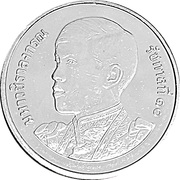
The one-baht coin is a denomination coin of the Thai baht, the Thai currency unit.

The Thailand five-baht coin is a denomination coin of the Thai baht, the Thai currency unit.
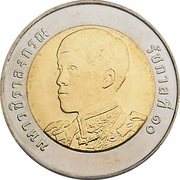
The bi-metallic Thailand ten-baht coin is a denomination coin of the Thai baht, the currency unit of Thailand.

Princess Siribha Chudabhorn, commonly known as Princess Ribha, is the eldest daughter of Princess Chulabhorn Walailak and Virayudh Tishyasarin.
The coins of the New Zealand dollar are used for the smallest physical currency available in New Zealand. The current denominations are ten cents, twenty cents, fifty cents, one dollar and two dollars. The $1 and $2 coins are minted in a gold colour, the 20c and 50c coins are silver colour and the 10c coin is plated in copper.
State decorations awarded by Thai King take the form of orders and medals. This page lists them by order of precedence.

The royal flags of Thailand are personal royal flags that are usually flown in Thailand, along with the national flag, to honor the King and royal family. Unlike the royal standards displayed only in special ceremonies and in particular locations, the royal flags are seen throughout Thailand. They are not commonly seen outside the country.
The history of Thai money used as a medium of exchange and to settle accounts before the adoption of Thai baht coins and banknotes include novel designs and forms. For Thai people, money was considered as the symbol of civilization. Currency itself reflected faith in religion, culture, the customs and traditions of each era and also serve as a record of the development of Thailand.
The Pavilion of Regalia, Royal Decorations and Coins is a museum showcasing regalia, royal Thai decorations of the early period, historical Thai money and ornaments used in the royal courts. It is under the supervision of the Bureau of Grand National Treasure, the Treasury Department which has the responsibility to safeguard, conserve, and display national treasures.

The Faculty of Medicine, Khon Kaen University is the fifth oldest medical school in Thailand located in Mueang Khon Kaen District, Khon Kaen Province, the second medical school to be set up in a region outside Bangkok and is the sixth oldest faculty of Khon Kaen University.
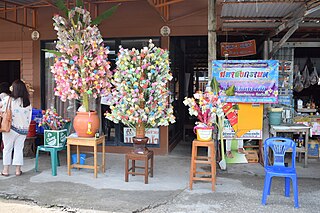
The banknotes of the Thai baht are part of the physical form of the Thai baht, Thailand's currency. The issuance of the baht banknotes is managed by the Bank of Thailand. Throughout its history, the denominations have ranged from 1 baht to 1,000 baht. The circulating banknotes today in Thailand, however, are ranged from 20 baht, 50 baht, 100 baht, 500 baht and 1000 baht. The currently circulating series are 17th, 16th and 15th series. Thai baht banknotes commonly include the portrait or the picture of the sculpture of its kings. The obverses have been designed with the current king's portrait. Whilst, in the reverses, mostly the picture of notable kings and kings with the title "the great". Some reverses feature the King Bhumibol's sayings.
The 20 baht note (20฿) is currently the lowest-in-value baht banknote and has been used since 1892. The 17th series notes are currently in circulation having been introduced in 2018. The 15th, 16th and 16th (special) series are commonly used as well. The front side shows a portrait of Vajiralongkorn, the current head of the state or the king. The reverse depicts Kings Phra Buddha Yodfa Chulaloke and Phra Buddha Loetla Nabhalai. Since 2022, this denomination has been printed in polymer.
